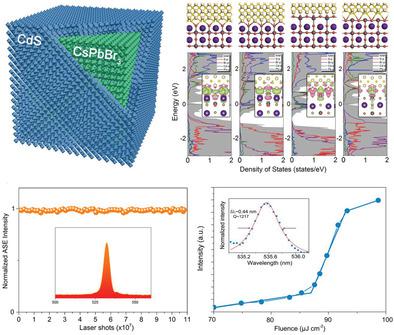Our official English website, www.x-mol.net, welcomes your
feedback! (Note: you will need to create a separate account there.)
Single Halide Perovskite/Semiconductor Core/Shell Quantum Dots with Ultrastability and Nonblinking Properties
Advanced Science ( IF 14.3 ) Pub Date : 2019-07-01 , DOI: 10.1002/advs.201900412
Xiaosheng Tang 1 , Jie Yang 1 , Shiqi Li 1 , Zhengzheng Liu 2, 3 , Zhiping Hu 1 , Jiongyue Hao 1 , Juan Du 2, 3 , Yuxin Leng 2, 3 , Haiyan Qin 4 , Xing Lin 4 , Yue Lin 5 , Yuxi Tian 6 , Miao Zhou 1 , Qihua Xiong 7
Advanced Science ( IF 14.3 ) Pub Date : 2019-07-01 , DOI: 10.1002/advs.201900412
Xiaosheng Tang 1 , Jie Yang 1 , Shiqi Li 1 , Zhengzheng Liu 2, 3 , Zhiping Hu 1 , Jiongyue Hao 1 , Juan Du 2, 3 , Yuxin Leng 2, 3 , Haiyan Qin 4 , Xing Lin 4 , Yue Lin 5 , Yuxi Tian 6 , Miao Zhou 1 , Qihua Xiong 7
Affiliation

|
The further practical applications of halide perovskite quantum dots (QDs) are blocked by problems of instability and nonradiative Auger recombination manifested as photoluminescence blinking. Here, single core/shell structured perovskite semiconductor QDs are successfully fabricated by capping CsPbBr3 QD core with CdS shell. It is demonstrated that CsPbBr3/CdS core/shell QDs exhibit ultrahigh chemical stability and nonblinking photoluminescence with high quantum yield due to the reduced electronic traps within the core/shell structure. Efficiency of amplified spontaneous emission exhibits obvious enhancement compared to that of pure CsPbBr3 QDs, originating from the mitigated competition between stimulated emission and suppressed nonradiative biexciton Auger recombination. Furthermore, low‐threshold whispering‐gallery‐mode lasing with a high‐quality factor is achieved by incorporating CsPbBr3/CdS QDs into microtubule resonators. Density functional theory (DFT)‐based first‐principles calculations are also performed to reveal the atomic interface structure, which supports the existence of CsPbBr3/CdS structure. An interesting feature of spatially separated charge density at CsPbBr3/CdS interface is found, which may greatly contribute to the suppressed Auger recombination. The results provide a practical approach to improve the stability and suppress the blinking of halide perovskite QDs, which may pave the way for future applications for various optoelectronic devices.
中文翻译:

具有超稳定性和不闪烁特性的单卤化物钙钛矿/半导体核/壳量子点
卤化物钙钛矿量子点(QD)的进一步实际应用受到不稳定和表现为光致发光闪烁的非辐射俄歇复合问题的阻碍。在这里,通过用CdS 壳覆盖 CsPbBr 3 QD 核,成功制备了单核/壳结构的钙钛矿半导体 QD 。结果表明,由于核/壳结构内电子陷阱的减少, CsPbBr 3 /CdS核/壳量子点表现出超高的化学稳定性和非闪烁光致发光以及高量子产率。与纯CsPbBr 3量子点相比,放大自发发射的效率表现出明显的增强,这源于受激发射和受抑制的非辐射双激子俄歇复合之间的竞争减弱。此外,通过将 CsPbBr 3 /CdS QD 合并到微管谐振器中,可以实现具有高质量因子的低阈值回音壁模式激光。基于密度泛函理论(DFT)的第一性原理计算也揭示了原子界面结构,支持了CsPbBr 3 /CdS结构的存在。我们发现了 CsPbBr 3 /CdS 界面上空间分离电荷密度的一个有趣特征,这可能极大地有助于抑制俄歇复合。研究结果为提高卤化物钙钛矿量子点的稳定性和抑制闪烁提供了一种实用的方法,这可能为各种光电器件的未来应用铺平道路。
更新日期:2019-07-01
中文翻译:

具有超稳定性和不闪烁特性的单卤化物钙钛矿/半导体核/壳量子点
卤化物钙钛矿量子点(QD)的进一步实际应用受到不稳定和表现为光致发光闪烁的非辐射俄歇复合问题的阻碍。在这里,通过用CdS 壳覆盖 CsPbBr 3 QD 核,成功制备了单核/壳结构的钙钛矿半导体 QD 。结果表明,由于核/壳结构内电子陷阱的减少, CsPbBr 3 /CdS核/壳量子点表现出超高的化学稳定性和非闪烁光致发光以及高量子产率。与纯CsPbBr 3量子点相比,放大自发发射的效率表现出明显的增强,这源于受激发射和受抑制的非辐射双激子俄歇复合之间的竞争减弱。此外,通过将 CsPbBr 3 /CdS QD 合并到微管谐振器中,可以实现具有高质量因子的低阈值回音壁模式激光。基于密度泛函理论(DFT)的第一性原理计算也揭示了原子界面结构,支持了CsPbBr 3 /CdS结构的存在。我们发现了 CsPbBr 3 /CdS 界面上空间分离电荷密度的一个有趣特征,这可能极大地有助于抑制俄歇复合。研究结果为提高卤化物钙钛矿量子点的稳定性和抑制闪烁提供了一种实用的方法,这可能为各种光电器件的未来应用铺平道路。































 京公网安备 11010802027423号
京公网安备 11010802027423号